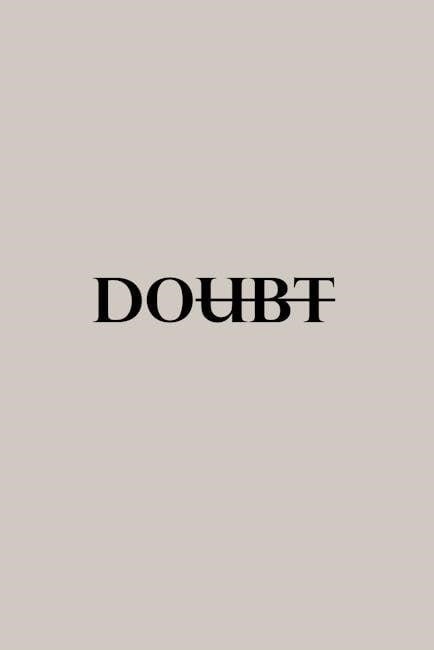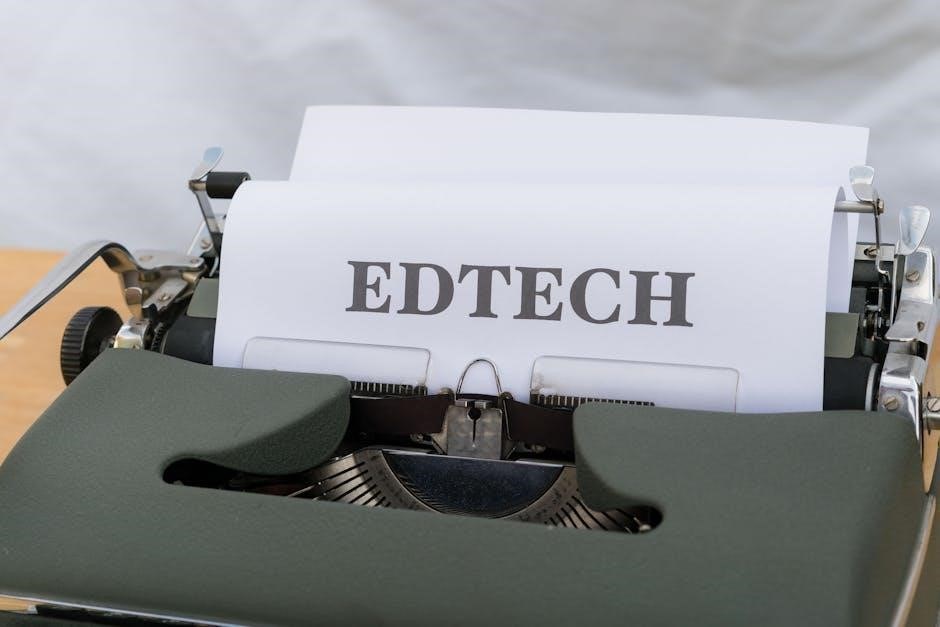Consonant blends are combinations of consonant sounds without a vowel between them, crucial for decoding words․ They include beginning, final, and medial blends, such as str in “strong” or spl in “splash․” These blends help students read complex words fluently, enhancing phonics skills and vocabulary growth․ Free PDF word lists and activities are available online to support learning and teaching consonant blends effectively․
Definition of Consonant Blends
A consonant blend is a combination of two or three consonant sounds that appear together in a word without a vowel sound separating them․ Each consonant in the blend retains its individual sound, creating a smooth transition between sounds․ For example, in the word “splash,” the sounds /s/ and /p/ blend together to form the initial consonant cluster․ Consonant blends can occur at the beginning, middle, or end of a word and are essential for accurate pronunciation and decoding skills․ They differ from digraphs, where two consonants make a single sound, as blends preserve the distinct sounds of each consonant․ Understanding blends is crucial for phonics instruction and reading fluency, as they appear frequently in English words like “strong” (/str/) or “black” (/bl/)․
Importance of Consonant Blends in Phonics
Consonant blends are fundamental in phonics instruction as they help students decode words by recognizing combinations of sounds․ They bridge the gap between individual consonant sounds and complex words, enhancing reading fluency and accuracy․ Mastery of blends enables learners to tackle multisyllabic words and comprehend texts more effectively․ For example, blends like /str/ in “strong” or /spl/ in “splash” are essential for accurate pronunciation․ These skills are foundational for beginning readers, as they build confidence and proficiency in reading․ Additionally, consonant blends improve spelling abilities and vocabulary growth, making them a crucial component of early literacy education․ Free word lists and activities, such as those found in PDF resources, provide practical tools for teaching and reinforcing these skills in the classroom and at home․

Types of Consonant Blends
Consonant blends are categorized into beginning, final, and medial blends․ They occur when two or three consonants appear together in a word, aiding in reading and spelling complex words effectively․
Beginning Consonant Blends
Beginning consonant blends occur at the start of words and involve two or three consonant sounds pronounced together․ These blends are crucial for phonics mastery; Common examples include /pl/, /tr/, and /sk/․ Words like plash, trip, and skip demonstrate these blends․ They help readers decode words by sounding out the combined consonants․ For instance, in blast, the /bl/ sound is a blend․ These blends are often introduced early in reading instruction to build foundational skills․ Many free PDF word lists are available online, offering practice exercises for learners․ These resources typically categorize blends, making it easier for students to focus on specific sounds․ Mastering beginning blends enhances reading fluency and spelling accuracy, as they appear frequently in English words․
Final Consonant Blends
Final consonant blends occur at the end of words and involve two or three consonant sounds pronounced together․ These blends are essential for accurate word recognition․ Common examples include /nd/, /mp/, and /tch/․ Words like hand, jump, and watch illustrate these blends․ They assist readers in decoding complex word endings, improving reading fluency․ For instance, in blast, the /st/ sound is a final blend․ Many free PDF word lists categorize these blends, offering targeted practice․ These resources help learners master sounds like /ng/ in sing or /ld/ in bold․ Final blends are vital for spelling and decoding skills, as they frequently appear in English words․ Practicing these blends enhances reading proficiency and vocabulary development․
Medial Consonant Blends
Medial consonant blends occur in the middle of words and involve two or more consonant sounds together․ These blends are crucial for decoding and reading fluency․ Common examples include /ck/, /tch/, and /str/․ Words like pucker, matchstick, and strong demonstrate these blends․ They help readers recognize patterns in word structure, enhancing decoding skills․ For instance, the /ck/ blend in chicken or the /tch/ in hatchet shows how these combinations aid in pronouncing words accurately․ Many free PDF word lists focus on medial blends, offering practice exercises․ Mastering these blends improves reading speed and comprehension, as they frequently appear in English vocabulary․ Regular practice with such word lists is essential for building confidence and proficiency in reading․

Common Consonant Blend Word Lists
Free PDF word lists are excellent resources for teaching consonant blends․ They organize words by blend type, such as /pl/, /tr/, and /sk/, aiding phonics instruction and reading practice․

Examples of Words with R-Blends
R-blends are combinations of the /r/ sound with other consonants․ Common R-blend words include frog, rabbit, carriage, train, and bridge․ These words often appear in consonant blend word lists for practice․ Examples like tree, crab, and dragon demonstrate R-blends at the beginning, middle, or end of words․ These lists help students recognize and decode R-blends effectively, improving reading fluency and spelling skills․ PDF resources often categorize these words, making them easy to use in classroom activities or homework․ R-blends are essential for building phonics mastery and are frequently included in educational materials for early readers․
Examples of Words with S-Blends
S-blends combine the /s/ sound with other consonants, creating distinct sounds․ Common S-blend words include splash, split, snake, blast, and crust․ Words like skate, stick, and spider also feature S-blends․ These words are often included in consonant blend word lists for practice, helping students recognize and decode S-blends effectively․ PDF resources frequently categorize these examples, making them accessible for classroom use or independent study․ S-blends are crucial for phonics development, especially in early reading stages; These words help improve decoding skills and enhance vocabulary growth, making them a staple in educational materials for teaching consonant blends․
Examples of Words with L-Blends
L-blends combine the /l/ sound with other consonants, creating unique sounds․ Common examples include black, blast, plug, and flood․ Words like blood, flip, and slide also feature L-blends․ These words are often included in consonant blend word lists, particularly in PDF resources, to help students practice decoding․ L-blends are essential for improving phonics skills and are frequently used in educational materials․ By mastering these words, students can enhance their reading fluency and vocabulary․ L-blend examples are widely available in printable lists, making them accessible for classroom instruction or at-home practice․ These words are fundamental for building strong decoding abilities in early readers․

Examples of Words with T-Blends
T-blends combine the /t/ sound with other consonants, creating distinct sounds․ Common examples include trip, straw, splash, and stretch․ Words like strong, twist, and split also feature T-blends․ These words are often included in consonant blend word lists, particularly in PDF resources, to aid in phonics instruction․ T-blends can appear at the beginning or end of words, such as in top or last․ Practicing these words helps students improve their decoding skills and reading fluency․ T-blend examples are widely available in printable lists, making them easy to integrate into classroom activities or homework assignments․ These words are essential for building phonics mastery and are frequently used in educational materials for early readers․

Teaching Consonant Blends in the Classroom
Effective instruction involves modeling, guided practice, and independent activities․ Use word lists, games, and interactive tools to engage students․ Incorporate phonics lessons with printable PDF resources for structured learning and differentiated instruction․
Strategies for Phonemic Awareness
Phonemic awareness is foundational for mastering consonant blends․ Teachers can use oral exercises like sound isolation, blending, and segmentation․ For example, identifying the /pl/ sound in “play” or /tr/ in “train․” Students benefit from hearing and repeating blend sounds, then connecting them to letters․ Multi-sensory approaches, such as tapping or clapping sounds, reinforce learning․ Interactive games like “I Spy” with blend sounds engage students․ Using word lists, teachers can model blending sounds into words, fostering decoding skills․ Group and independent practice activities, such as sorting games or sound scavenger hunts, strengthen phonemic awareness․ These strategies build a strong base for reading and spelling, enabling students to recognize and reproduce consonant blends effectively․
Decodable Texts for Practice
Decodable texts are essential for practicing consonant blends, as they align with phonics skills being taught․ These texts use words containing targeted blends, such as /pl/, /tr/, or /sk/, allowing students to apply their knowledge․ Teachers can use consonant blends word lists to create or select decodable passages․ Start with controlled texts that focus on one blend at a time, gradually introducing more complex combinations․ Guided reading sessions help students decode unfamiliar words and build fluency․ Independent reading opportunities reinforce skills, while progress monitoring ensures mastery․ Decodable texts are a bridge between phonics instruction and real reading, making practice purposeful and engaging․ They are a cornerstone of systematic phonics instruction, fostering confidence and decoding accuracy in learners․
Activities for Reinforcement
Engaging activities are crucial for reinforcing consonant blends․ Use word lists to create games like bingo or scavenger hunts, where students identify and read blend words․ Sorting games, where words are categorized by their initial or final blends, enhance recognition․ Magnetic letter building allows students to manipulate sounds and blend them․ Reading stations with blend-focused texts encourage practice in a collaborative setting․ Interactive digital tools, such as online sorting games, make learning fun․ Crafts, like creating blend word posters, reinforce memory․ These activities make learning interactive and memorable, ensuring students master consonant blends effectively while staying motivated and engaged in their learning journey․

Consonant Blends and Vocabulary Growth
Consonant blends expand vocabulary by aiding word recognition․ They help decode complex words, enabling readers to identify word parts and build stronger vocabulary skills effectively․
Role of Blends in Word Recognition
Consonant blends play a crucial role in word recognition by providing familiar sound patterns that aid in decoding words․ These combinations of consonants, like ‘bl’ in ‘black’ or ‘str’ in ‘street’, help readers identify word parts and pronounce them accurately․ Blends at the beginning of words, such as ‘tr’ in ‘train’, serve as shortcuts, making words easier to recognize and remember․ While beginning blends may be more critical for setting the tone of a word, ending blends like ‘st’ in ‘ghost’ also contribute to a word’s identity․ The interaction of blends with vowels, as in ‘pl’ in ‘play’, creates unique sound identifiers, enhancing recognition․ This skill is especially vital for early readers, allowing them to decode and pronounce words more effectively, though exceptions like ‘sword’ require additional learning․ Overall, blends streamline reading by offering consistent sound patterns․
Building Decoding Skills
Decoding skills are essential for reading proficiency, and consonant blends play a significant role in this process․ By recognizing blends, readers can break down words into manageable parts, improving their ability to decode unfamiliar words․ For example, understanding the ‘bl’ blend in “black” or “blast” helps readers identify the word’s starting sound․ This skill is particularly important for early readers, as it builds confidence and fluency․ Regular practice with decodable texts and word lists, such as those found in consonant blends word lists, reinforces these skills․ Activities that focus on identifying and segmenting blends also strengthen decoding abilities․ As learners progress, they can apply these skills to more complex words, solidifying their foundation in phonics and reading comprehension․

Resources for Consonant Blends
Free consonant blends word list PDFs are widely available online, offering educators and parents organized tools for targeted practice and reinforcement of phonics skills․
Free PDF Word Lists Available Online
Free consonant blends word list PDFs are excellent resources for educators and parents, offering organized and printable materials for phonics instruction․ These PDFs typically include categorized lists of words containing specific blends, such as /r/, /s/, /l/, and /t/ blends, along with example sentences and images to aid comprehension․ Many are designed for classroom use, with activities and exercises to reinforce learning․ They often target different skill levels, from beginner to advanced, ensuring suitability for various student needs․ Some PDFs also include games and worksheets, making practice engaging and interactive․ Teachers can print these lists for group activities or share them digitally for independent study․ Additionally, they provide opportunities for differentiated instruction, catering to diverse learning styles and abilities․ These resources are invaluable for helping students master consonant blends and improve overall reading proficiency․
Speech Therapy Activities

Speech therapy activities incorporating consonant blends word lists are highly effective for improving articulation and phonological awareness․ One popular activity involves auditory discrimination games, where students identify words with specific blends․ For example, a therapist might say a word and ask the student to repeat it, focusing on accurate blend production․ Another activity includes blending cards, where students match initial and final blends to form complete words․ Articulation drills, such as repeating words in isolation and in sentences, are also common․ Interactive games like “Blend Bingo” or “Blend Scavenger Hunts” make practice engaging․ Additionally, therapists often use multi-sensory approaches, such as tapping out sounds or using visual aids, to reinforce learning․ These activities are tailored to individual needs and progress levels, helping students build confidence and fluency in using consonant blends․
Online Tools for Practice
Online tools offer engaging and accessible ways to practice consonant blends, supplementing word lists․ Interactive games like Starfall and Reading Bear provide audio-visual support, helping students hear and repeat blend sounds․ Phonics Hero and Teach Your Monster to Read are popular platforms that incorporate blend practice into fun, gamified activities․ Many websites, such as Phonics Bloom, offer free interactive exercises and quizzes tailored to specific blends․ Apps like Blends Bingo and Articulate It! allow students to practice blending sounds in a hands-on manner․ These tools often include progress tracking, making it easy for educators and parents to monitor improvement․ By leveraging technology, learners can practice anytime, anywhere, reinforcing their understanding of consonant blends in a dynamic and engaging way․

Assessment and Intervention
Assessment evaluates students’ consonant blend mastery, enabling tailored interventions like extra practice sheets, one-on-one tutoring, or interactive games to address specific challenges effectively․
Evaluating Student Mastery
Evaluating student mastery of consonant blends involves assessing their ability to recognize, read, and spell words containing these blends accurately․ Teachers can use consonant blends word list PDFs to create quizzes, reading exercises, and spelling tests․ These assessments help identify students who may need additional support․ Progress monitoring tools, such as timed readings or phonics games, can track improvements over time․ It’s essential to align assessments with instruction to ensure students are mastering the specific blends taught․ Providing immediate feedback and targeted practice helps reinforce learning․ Regular evaluations ensure students are ready to move to more complex skills, making consonant blends word lists a valuable resource for both teaching and assessment․ Consistent evaluation supports personalized instruction and fosters confidence in reading and spelling abilities․ By using these tools effectively, educators can address learning gaps early and promote overall literacy growth․
Intervention Strategies for Struggling Readers
For students struggling with consonant blends, targeted interventions are essential to build proficiency․ Using consonant blends word list PDFs, teachers can provide explicit practice through phonics-based activities․ Multisensory approaches, such as writing words in sand or shaving cream, engage tactile learners․ Small-group instruction allows for personalized feedback, while peer tutoring fosters collaborative learning․ Technology tools, like interactive games, offer engaging practice opportunities․ Progress monitoring with pre- and post-assessments using word lists helps track growth․ Explicit instruction in blending sounds and segmenting words is critical․ By incorporating these strategies, educators can address gaps and help struggling readers master consonant blends effectively․ Consistent practice with word lists ensures long-term retention and improved decoding skills․
Consonant blends are essential for building reading and spelling skills, combining two or more consonants to form a single sound․ A consonant blends word list PDF offers a structured approach to learning these sounds, providing clear examples and practice opportunities․ By focusing on blends like /bl/, /str/, and /pl/, learners can improve phonemic awareness and decoding abilities․ These resources are particularly useful for educators, parents, and speech therapists, as they cater to diverse learning needs․ Regular practice with such lists enhances fluency, vocabulary, and overall literacy development․ Incorporating games, activities, and decodable texts alongside these lists ensures a comprehensive understanding of consonant blends, making them a valuable tool for effective teaching and learning․
Future Directions in Teaching Consonant Blends
Future teaching strategies for consonant blends may focus on integrating technology, such as interactive PDFs and digital tools, to enhance engagement․ Personalized learning plans using consonant blends word lists can cater to individual student needs, ensuring mastery at their own pace․ Incorporating gamification and multimedia elements, like audio clips for pronunciation, can make practice more dynamic․ Additionally, educators can explore blending physical and digital resources, such as printable PDFs paired with online exercises, to create a hybrid learning experience․ Regular updates to word lists based on curriculum changes and student feedback will keep resources relevant․ By leveraging data analytics, teachers can track progress and tailor instruction effectively․ Collaboration between educators and developers will further refine these tools, ensuring they remain effective and accessible for all learners․
